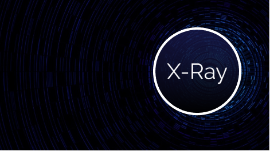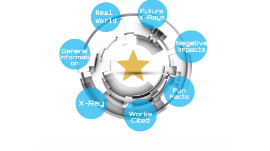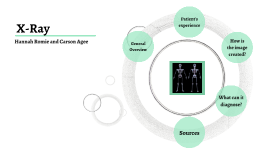X-ray Presentation
Transcript: X-Ray's Imagine being in a car, in the passenger seat. And all of the sudden out of nowhere, your car is struck by another, your body flails all over the place like your a crash dummy, and you are so dumbfounded by what just happen you can barely even remember it. An ambulance brings you to the hospital to see what could possibly be wrong, you arrive at the hospital and are immediately scanned by an x-ray, and 10 minutes later you find out that your arm is broken. Background Info Intro + X-rays are a quick and painless ray that have many different functions in our daily lives, they can do anything from diagnosing cancer to treating that cancer. X-rays have opened up many different opportunities for America by letting doctors precisely detect injuries in their patients, aiding in the development of CT scans which help doctors to diagnose diseases, and finally by detecting fail points/flaws inside of structures and metals. All About X-Rays About Who Wilhelm Conrad Rontgen was a German mechanical engineer and physicist, who in November 1895, discovered electromagnetic radiation in a wavelength range known as X-rays or as some may know it, Roentgen rays. Wilhelm Conrad Röntgen Wilhelm's first ever x-ray was of his wife's hand This was an achievement that gifted him with the first Nobel Prize in Physics in 1901 as he was the first person to discover electromagnetic radiation in a wavelength range, which are known to us as X-rays today. Although, many people had observed the effects of X-ray beams before, Wilhelm Roentgen was the first one to study them systematically and as many may say, "crack the code." Wilhelm Conrad Röntgen What X-rays are one of the seven high-energy forms of electromagnetic radiation. And these various forms of this energy can be distinguished by the size of their wavelengths, x-rays have very high-frequency wavelengths. What Are They? X-rays and named x-rays because Wilhelm C. Roentgen called them X-rays because at first, he did not understand what they were. And X is a scientific symbol for the unknown, and they were unknown because he discovered them accidentally while experimenting with vacuum tubes. Why X-Ray's? When In late 1895, a German physicist, W. C. Roentgen was working with a cathode ray tube in his laboratory that is located in Germany. He was working with tubes similar to our fluorescent light bulbs when he discovered x-rays. When Were They Discovered? Where Wilhelm C. Roentgen attended 3 different universities/colleges in Germany, the University of Zurich, the University of Strasbourg, and finally ETH Zurich. But he discovered x-rays while he was a professor at Wuerzburg University in Germany. Where Were They Discovered? How X-rays work by a series of chain reactions. First, an electric current goes through a connection known as a cathode, and then it heats that cathode up. The now heated cathode then releases electrons. A voltage is then spread across the cathode and a connection that is called the anode forces electrons to hit and strike a tungsten target, where these components then produce x-rays. How Are X-Ray's Created? The x-rays then exit the machine through a window and go onto make a physical image of what lies inside of a patient's body. And this happens because the bones absorb more rays than the muscles or internal organs because of the calcium they have i them, so because of this, the bones cast the sharpest white shadow on the plastic or film. Where They Then Go X-rays can be very dangerous and possibly lethal if they are not used by a professional in a controlled environment. They have been known to cause serious conditions such as cancer, skin burns, and anemia. This is why during these scans doctors always make sure to shield the parts of the body that are not being examined so that way less radiation is put into the body overall. How Dangerous Are They? Why Was It Needed? Why + X-rays help in looking at the inside of the body without having to cut open the body or make an incision like in a surgery, because back anytime before the 1800's this is how people were diagnosed. In this way, x-ray helps in diagnosing, monitoring, and treating many medical conditions. Plus X-ray carries very minor risks and the benefits of the x-rays outweigh its risks. Positive Aspects X-ray helps in looking at the inside of the body without having to cut open the body or make an incision like in a surgery, because back anytime before the 1800's this is how people were diagnosed. In this way, x-ray helps in diagnosing, monitoring, and treating many medical conditions. Plus X-ray carries very minor risks and the benefits of the x-rays outweigh its risks. X-ray helps in looking at the inside of the body without having to cut open the body or make an incision like in a surgery, because back anytime before the 1800's this is how people were diagnosed. In this way, x-ray helps in diagnosing, monitoring, and treating many medical conditions. Plus X-ray carries very minor risks and the

















